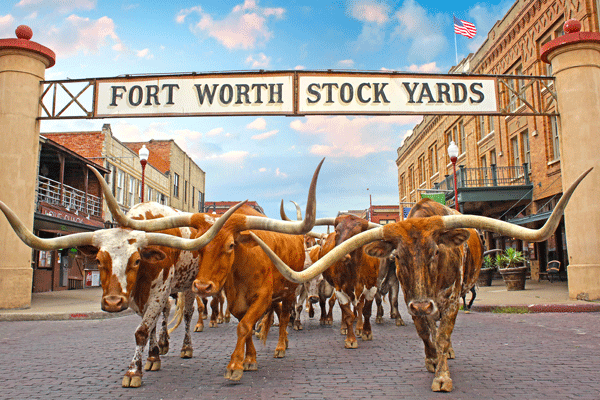The success of the Fort Worth Stockyards was due in part to luck, as exemplified in one case where the future was decided by the toss of a coin.
In the last half of the 19th century, Fort Worth became a major waypoint for cattlemen driving their herds north along the Chisholm Trail. It was the last opportunity these men would have to rest and resupply before crossing the Red River and moving north into Indian Territory. When the Texas and Pacific Railway arrived in 1876, Fort Worth was fertile ground for an enterprise such as the Fort Worth Stockyards to develop.
The Early Fort Worth Stockyards (1860s to 1900)
By 1886, four separate stockyards had been built near the new railroad. In 1887 businessmen (including Mike C. Hurley) chartered the Union Stockyards Company and Fort Worth Packing Company. Construction on the 258 acre facility began approximately two and a half miles north of the Tarrant County Courthouse. The Union Stockyards Company went into full operation in midsummer 1889.
The Union Stockyards Company lacked sufficient funding to lure local cattlemen to their stockyards and needed an infusion of funds from investors. President Mike C. Hurley invited Greenlief Simpson, a wealthy Boston businessman, to visit Fort Worth in the hopes of getting him to invest in the Union Stockyards. Due to freak heavy rains and a railroad strike, the pens at the Union Stockyards were more full than usual when Simpson arrived in Fort Worth. This tipped the scales in Hurley’s favor, and Simpson decided to invest in the Union Stockyards Company.
Simpson, along with several other associates from Boston and Chicago, incorporated the Fort Worth Stockyards in West Virginia in 1893. An associate of Simpson’s, Louville V. Nile, purchased half of the shares in the company.
The Boom Years of the Fort Worth Stockyards
Despite financial difficulties in the early years between 1893 and 1896, the Fort Worth Stockyards began to flourish. In 1896, the company began a livestock exposition (Southwestern Exposition and Livestock Show) that still continues to present day. Early successes also include the production of the largest newspaper dedicated to livestock in the Southwest.
One contributing factor to the success of the Fort Worth Stockyards was an agreement made in 1902 with Armour & Co. and Swift & Co. meat packers to build plants adjacent to the stockyard. The two businesses tossed a coin to determine which would get first choice in building site. Armour won the coin toss and selected the northern site, leaving the southern site to Swift.
Construction on the Livestock Exchange Building, also known as the “Wallstreet of the West”, also began in 1902. This building was designed to provide the support services (telegraph, livestock commission companies, etc) required by the rest of the Fort Worth Stockyards.
Construction began on the Northside Coliseum in 1907, in response to the need for an indoor show facility. Construction was completed in just 88 days, in time for the first Feeders & Breeders Show. The first indoor rodeo was held at the Northside Coliseum in 1918.
The Fort Worth Stockyards continued to prosper, despite weathering two World Wars, and reached its peak year in 1944 when it processed 5,277,496 head of livestock.
The Decline of the Fort Worth Stockyards
After reaching its peak year in 1944, the Fort Worth Stockyards began an inexorable decline. Railways as a means for transporting cattle became outmoded, and the packing plants that had been integral to the success of the Stockyards as a business were obsolete. Armour & Co. closed its doors in 1962, and after several fires the old Armour building was eventually demolished. Swift held out until 1971, but it too eventually closed its doors.
In 1976, the North Fort Worth Historical Society was formed by Charlie and Sue McCafferty. Their mission was to preserve Fort Worth’s historical livestock heritage. Later that year, the Fort Worth Stockyards National Historical District was established. In 1989, the North Fort Worth Historical Society opened the Fort Worth Stockyards Museum in the restored Exchange Building.
Thanks to the restoration and preservation efforts of the North Fort Worth Historical Society, visitors to the Fort Worth Stockyards today can still experience a piece of history that earned Fort Worth the nickname “Cowtown”.
Sources:
- Fort Worth Stockyards (2009), The Official History of the Fort Worth Stockyards
- North Fort Worth Historical Society (May 31, 2010), The Stockyards Museum: History of the Fort Worth Stockyards
- The Stockyards Hotel (2007), Stockyards History
- Pate, J’Nell L., Texas State Historical Association, The Handbook of Texas Online: Fort Worth Stockyards








